OTVA NEWSLETTER - December 2008 - Volume 10 - Page 39
THE OVERHEADS
Office Bearers 2008–2009
President: Peter Bull
Peter.Bull.NOC@optus.com.au
Phone: 0411 260 542
Secretary: Will Whyte
will.whyte@optus.com.au
Phone: 02 8082 5088
Treasurer: Bernie White
Phone: 02 9708 4666
Newsletter Editor: Bob Emanuel
bob.emanuel@verizonbusiness.com
Phone: 0412 062 236 or
4787 5558
OTVA Membership Subscription:
$10 p.a. -- Due in May each year.
(Please check your mailer as the indication “5/07”
indicates you are unfinancial)
Mail Address: Unit 805, 41 Meredith Street,
BANKSTOWN 2200
ABN 75 502 170 235
Website: www.otva.com
|
CONTENTS
President’s Message 39
New Members 40
Ceduna Santa 40
Hunt The Kaiser’s Cruisers - II 40
How The Coat Of Arms Was Saved 41
The Introduction Of Satellites to the Maritime Industry 42
Kurrajong Radio Museum Visit 42
An Extravagant Excrescence - I 45
An Extravagant Excrescence - II 46
Vale (Doug Lloyd, Gwen Salloway) 46
B-pay Your Annual Subs 47
Stories - Bedlam At The ITMC 47
Last Word 47
COMING EVENTS
NSW CHRISTMAS LUNCH AND REUNION
This will be held on Level 2 of the Bowlers’
Club in York Street, Sydney from 11.00am on November 14 2008. Please
note that 99 York Street is located on the Town Hall side of “The
Bowlers Club’ and not through the club, “The York Room”
is on Level 2 and access is via the lift. Cost of $35.00 is for
a sit–down Chinese banquet with table service. A bar is located
outside the function room and will be open from 11.00AM with luncheon
at 12 N00N.
During lunch Paul McCann will give us a short
update on the latest developments in terrestrial and submarine cable
technology.
Please book early! Please RSVP!
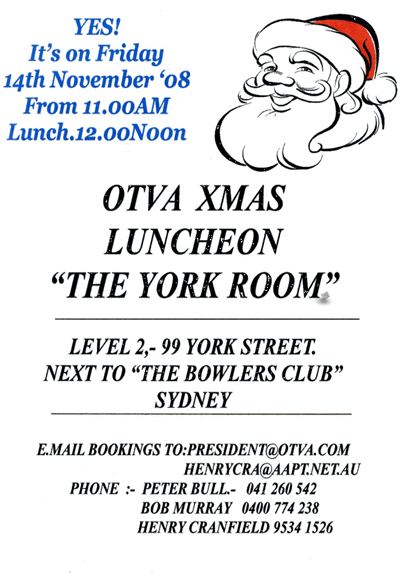
Victorian Branch OTVA Christmas Luncheon.
The Victorian Branch will be having their Christmas
Reunion on Saturday the 29th November 2 at Legacy House, 2nd Floor,293
Swanston Street Melbourne, just 50 metres north of Lonsdale Street
corner at 12 noon until 3pm or so.
R.S.V.P. 26th November 2008 or ASAP.
CONTACT: 95116969 or 0417527648.
Write to: Mr. R. Hall, 29 Merrill Street, MULGRAVE 3170.
EMAIL: rjmdolphin@optusnet.com.au
FUTURE OUTINGS:
Other suggestions for places which might interest Vets are sought.
Make your suggestion now to any Committee member!
FROM OUR PRESIDENT [Top]
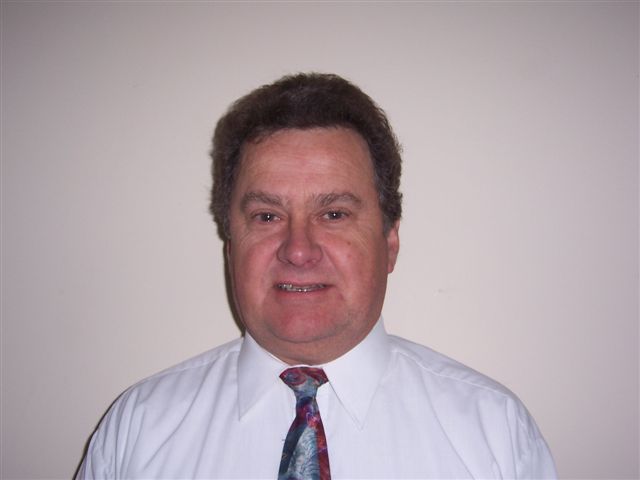 Fellow
Members of the OTVA, as Christmas draws near, I reflect upon another
year of development and progress in our association. Fellow
Members of the OTVA, as Christmas draws near, I reflect upon another
year of development and progress in our association.
Your continued support and involvement encourages
us to keep working for you. I thank all of the members of the OTVA
Executive for their hard work and dedication throughout 2008 and
wish them and their families a Merry Christmas and a Happy New year.
Since the AGM, your new Executive has been busy
on several fronts:
- Ray Hookway, Bernie White, Henry Cranfield and Allan Hennessey
have continued to work closely with the staff of the Telstra
Museum at Bankstown to preserve the historical artefacts derived
from OTC that you have entrusted to our care. The hard work
and dedication of these members of the team will result in the
preservation of this valuable collection for many years to come.
- Chris Bull continues to improve the quality and content of
the OTVA web site (http://www.otva.com). Chris is also looking
to add additional features that may be useful to members. Please
check out the web site and let me know what your think (email
to: president@otva.com). I am very interested in continuing
to improve the site and all ideas for additional content will
be warmly welcomed.
- We are continuing to identify and implement ways in which
to attract new members, particularly for the younger people
who don’t regard themselves as Veterans yet.
- We are continuing our efforts to create a relevant and up-to-date
constitution for the OTVA which has been attempted on several
occasions in the past but due to the complexities of the matter
had not progressed.
The tour of the Kurrajong Radio Museum was patronised
by about a dozen or so enthusiasts who enjoyed the nostalgia of
the items on display as well as the social banter over the lunch
that ensued after the tour.
Don Withers has been working with the staff of
the Telstra Museum at Bankstown to convert the OTC Video tapes to
DVD media to protect the content from loss due to the degradation
of the video tapes over time which is apparently occurring with
other tapes stored at the museum.
Together with the members of the OTVA Executive,
I wish you and yours a very Merry Christmas and a Happy New Year.
Have a safe and happy festive season.
I look forward to seeing you at the Christmas
social event on November 14 2008.
Peter Bull
NEW MEMBERS [Top]
A very warm welcome to our new members - Peter
Grove, formerly of International Relations and Gary ‘Sammy’
Samuels, formerly of the ISTC at Broadway, and Terry Nipperess of
ITMC and satellite fame.
CEDUNA SANTA [Top]
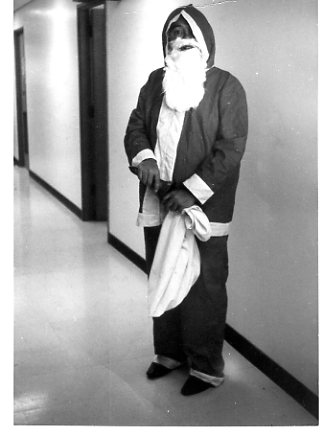
Does anyone recognise our Ceduna Santa of 1969?
Please contact your editor. Photo from Henry Cranfield.
HUNT THE KAISER’S CRUISERS.
[Top]
A follow-up by Bob Emanuel.
Following up on Gordon’s article in the last
edition, I found the source for the program material on a website.
It is a reproduction of the book 'The Voyage of the Emden' by Kapitaenleutnant
Hellmuth Von Muecke of His Emperor's Ship, the "Emden,"
translated by Helene S. White.
It can be seen on http://www.greatwardifferent.com/Great_War/Naval/Emden_01.htm
It contained all the errors Gordon highlighted.
Alas, as the good Kapitaenleutnant is long dead, there’s not
much point in asking for a correction.
That web site is full of articles well worth a
read. It tells the “history” of World War 1 from the
German perspective. It makes no moral judgements as to who was right
and wrong.
How The OTC Coat of Arms Was
Saved. [Top]
By Tom Barker
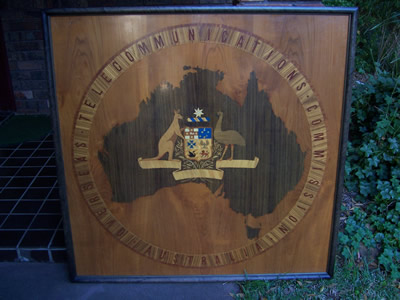 Let
me begin this story with a disclaimer. Most of this is hearsay and
it was told to me by someone who (sadly) cannot protest his innocence.
Like many of the best stories we all know about episodes in our
careers, this tale was never supposed to appear in print, due to
fears of libel suits or worse. Let
me begin this story with a disclaimer. Most of this is hearsay and
it was told to me by someone who (sadly) cannot protest his innocence.
Like many of the best stories we all know about episodes in our
careers, this tale was never supposed to appear in print, due to
fears of libel suits or worse.
However, during the enjoyable lunch which followed our very successful
2008 OTVA AGM, I was approached by our newly elected Newsletter
Editor, Bob Emanuel (congratulations Bob) (thanks Tom) who asked
me to set the record straight on this matter.
Now this story is mainly about a man we all knew
and loved, the late, unique and irreplicable* Eamon Fitzpatrick
and I shall try to tell it as he told it to me.
Following the merger of OTC with Telecom Australia,
to create Telstra, much of the considerable collection of artefacts
and archival materials which OTC had accumulated as a record of
its (and Australia’s) international telecommunications history
was being gathered up and disposed of in a rather ruthless fashion.
Those items which particularly related to OTC were deemed to be
of lesser value than those with a more general historic pedigree.
Amongst the former was an handsome wooden board
, which had been mounted on the walls of the OTC Board Rooms, originally
at Spring Street, then Martin Place and finally at Elizabeth Street.
About four feet (120cm) square, it had the circular crest of OTC
engraved upon it and it was a unique piece of OTC history; more
than that, it was the “Holy Grail” of OTC artefacts.
So it came to pass that one afternoon, Eamon Fitzpatrick
received a phone call from someone whose name I have conveniently
forgotten. He was told that a crew was on its way to Elizabeth Street,
with a truck, which was to be loaded with the contents of all the
display cabinets and other such spaces in that building and that
the “valuable items” such as the art works, were to
be taken into a protected space, while all other materials were
go directly to the tip. Particular mention was made of the OTC Coat
of Arms in the Board Room, which was not to survive that afternoon.
Eamon was asked to act swiftly and “do something about it”.
Now Eamon didn’t drive, as we all know,
but he was an avid collector and he did all his collecting with
a wheelbarrow, so how he managed this we do not know, but the OTC
Coat of Arms found a safe refuge in his garage, the repository for
a host of memorabilia from Eamon’s life, as a British Commando,
an OTC Technician and a Volunteer Fireman. Many of us who attended
Eamon’s funeral, went afterwards to the wake which was held
in that garage. We were astonished to behold the remarkable collection
which he cherished so dearly and spent hours polishing and dusting.
We couldn’t resist searching for one particular item but we
would not have found it without the aid of his daughter, who showed
us its secret hiding place.
This story has an unexpected happy ending. Following
its discovery, an approach was made to Eamon’s family by our
worthy President, who obtained their permission to recover several
items, including the OTC Coat of Arms, from the garage and take
them to a new sanctuary, which was successfully achieved. So, not
only did the OTC Coat of Arms survive the threat of destruction
but it may even be seen on display again, on some appropriate occasion.
*I like that newly minted word so much, Tom, that
I have had to add it to my dictionary – Bob E.
The Introduction of
Satellite Communications to the Maritime Industry. [Top]
By Henry Cranfield
Post World War 11, the International maritime
industry abided by the rules set prior to same by each nation and
all shipping complied with an international convention known as
“SOLAS” for safety of life at sea communications. This
was upgraded over varying intervals and in 1948, it was recognized
that the convention was out of date and a new (3rd) version was
agreed to, which made it mandatory for all ships of 300 gross tons
or over to carry a radio installation. It also required those of
over 500 gross tons to carry radio-telephone and direction finding
equipment. The introduction of transistorized equipment, made it
was possible to use higher frequencies, reduced its physical size
and power consumption. The use of radio- telephone equipment grew
rapidly and radiotelegraphy was mainly used by larger vessels.
At the same time, the ships themselves were undergoing
a dramatic change in design. Passenger liners became luxurious cruise
ships, container ships replaced cargo boats and bulk carriers of
100,000 tons and over, were used for the transport of minerals,
oil and grain.
These changes also altered the communication requirements
on ships, as owners wanted more detailed reporting of fuel use,
better weather forecasts and position reports. Also, it was recognized
that the “SOLAS requirements did not meet the new needs and
the newer technology e.g. satellites offered great improvements
in maritime communications.
In 1959, the “International Maritime Organization”
(IMO), now a United Nations agency, was formed to improve maritime
safety globally and to draw up regulations which included such matters
as pollution, safe practices and the handling of disasters.
In 1979, a group of experts drew up the “International
Convention on Maritime Search and Rescue” which called for
a global search and rescue plan and also called for IMO to develop
a “Global Maritime Distress and Safety System {GMDSS} to provide
communications support for its plan. This new system was based on
the use of satellite and terrestrial radio services to provide distress
communications and changed the previous “Ship to ship”
based system, to a “Ship to shore based rescue co-ordination
centre” system. This brought about the end of “Morse
code” communications in the maritime world!
The GMDSS provided for automatic distress alerting
and location It also required ships to receive broadcasts of marine
safety messages [known as NAVTEX] to prevent a distress happening.
In 1988 it became mandatory for all ships to carry “Electronic
Position. Indicating Beacons [EPIRB] and to carry full GMDSS provisioning
by August 1993 and there was no longer requirement for morse equipment
from then on. This span of time allowed for all the maritime nations
to meet the requirements and to provide time to transfer to a fully
satellite based system.
The GMDSS System.
The Global Maritime Distress Safety System (GMDSS) is an internationally
agreed-upon set of safety procedures, types of equipment, and communication
protocols used to increase safety and make it easier to rescue distressed
ships, boats, aircraft and adventurers. GMDSS consists of several
systems, many of which have been in operation for many years. The
system is intended to perform the following functions: alerting (including
position determination of the unit in distress), search and rescue
coordination, locating (homing), maritime safety information broadcasts,
general communications, and bridge-to-bridge communications. Specific
radio carriage requirements depend upon the ship's area of operation,
rather than its tonnage. The system also provides redundant means
of distress alerting, and emergency sources of power. Recreational
vessels do not need to comply with GMDSS radio carriage requirements,
but increasingly use the Digital Selective Calling (DSC) VHF radios
and offshore vessels may elect to equip themselves further.
The System’s Major requirements are:
- A Search and Rescue Transponder. The GMDSS installation on
ships must include one or more Search and Rescue Transponder
(SART) devices which are used to locate survival craft or distressed
vessels by creating a series of dots on a rescuing ship's radar
display. The detection range is normally about 15 km (8 nautical
miles). Note that marine radar may not detect a SART even within
this distance, if the radar settings are not optimized for SART
detection .Once detected by radar, the SART will produce a visual
and aural alarm
- Digital Selective Calling. The IMO also introduced Digital
Selective Calling (DSC) on MF, HF and VHF maritime radios as
part of the GMDSS system. DSC is primarily intended to initiate
ship-to-ship, ship-to-shore and shore-to-ship radiotelephone
and MF/HF radiotelex calls. DSC calls can also be made to individual
stations, groups of stations, or "all stations" in
one's reach. Each DSC-equipped ship, shore station and group
is assigned a unique 9-digit Maritime Mobile Service Identity.
DSC distress alerts, which consist of a preformatted distress
message, are used to initiate emergency communications with
ships and rescue coordination centres. DSC was intended to eliminate
the need for persons on a ship's bridge or on shore to continuously
guard radio receivers on voice radio channels, including VHF
channel 16 (156.8 MHz) and 2182 kHz now used for distress, safety
and calling. A listening watch aboard GMDSS-equipped ships on
2182 kHz ended on February 1, 1999. In May 2002, IMO decided
to postpone cessation of a VHF listening watch aboard ships
ending on 1 February 2005.IMO and ITU both require that the
DSC-equipped MF/HF and VHF radios be externally connected to
a satellite navigation receiver. That connection will ensure
accurate location information is sent to a rescue coordination
centre if a distress alert is ever transmitted. Today all marine
radiotelephone equipment to have DSC capability be it HF or
VHF
- Emergency Position-Indicating Radio Beacon (EPIRB) Cospas-Sarsat
is an international satellite-based search and rescue system,
established by Canada, France, the United States, and Russia.
These four countries jointly helped develop the 406 MHz Emergency
Position-Indicating Radio Beacon (EPIRB), an element of the
GMDSS designed to operate with Cospas-Sarsat system. These automatic-activating
EPIRBs, now required on SOLAS ships, commercial fishing vessels,
and all passenger ships, are designed to transmit to a rescue
coordination center a vessel identification and an accurate
location of the vessel from anywhere in the world. Today’s
designs incorporate GPS receivers to transmit highly accurate
positions of distress and in the location Tasks.
- NAVTEX. Navtex is an international, automated system for instantly
distributing maritime navigational warnings, weather forecasts
and warnings, search and rescue notices and similar information
to ships. A small, low-cost and self-contained "smart"
printing radio receiver installed in the pilot house of a ship
or boat checks each incoming message to see if it has been received
during an earlier transmission, or if it is of a category of
no interest to the ship's master. The messages are coded with
a header code identified by the using alphabets to represent
broadcasting stations, type of messages, and followed by two
figures indicating the serial number of the message.
Australia, through the offices of The Department
of Communications, Australian Maritime Safety Authority[AMSA] and
OTC made significant contributions to the establishment of the GMDSS
as our area (Nav. Area 10) covers from Mid Indian ocean(90E.) to
the middle of the Tasman sea (170E0 and from the Equator (00S)to
50Deg south in the Southern Ocean. It has been divided into 5 areas
within its boundaries, to enable better weather forecasting and
reducing the message lengths.
The actual INMARSAT Story will be in a further article.
Kurrajong Radio Museum Visit.
[Top]
By Tom Barker
Our visit to the Radio Museum at Kurrajong, on
13 September, was a great success, despite the small number of OTVA
members who were able to make the trip.
It was a beautiful, summery day, that Saturday,
in stark contrast to the horrible wintry weather that we had experienced
in the weeks prior to that date, so the trip up the Blue Mountains
turned out to be a thoroughly enjoyable one, regardless of what
we might have found there. This proved to be quite extraordinary
and far beyond what most of us had expected.
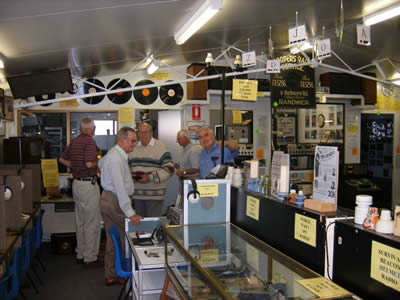
Ken Theaker, Bernie White, Tom Barker, Tony Stuart
and Ian O’Toole at the Museum.
I say “most”, because some of our party
were already familiar with the museum and its founder, Ian O'Toole,
who is a well-known identity amongst the radio community.
Ian and his wife, Pat, have spent years accumulating,
cataloguing and classifying an enormous range of equipment, documents,
photographs, records and associated memorabilia, relating to the
history of radio in Australia, including commercial broadcasting,
military communications, international telecommunications and amateur
radio. The collection is so extensive that only a part of it is
on display at any time and Ian regularly recycles various items,
from the storage area into the museum display, in order to maintain
a changing experience for his visitors.
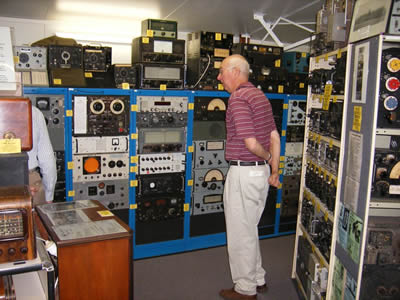
Ken Theaker amid the rows and rows of radios at
the Kurrajong Radio Museum.
There are rows and rows of radio receivers, transmitters
and transceivers, of all ages, arranged on shelves, most of which
have been restored to working order and all labelled with their
technical descriptions and usages, etc, There is a host of various
equipment familiar to ex-OTC people, as well as video displays and
sound recordings of significant events such as the opening of ANZCAN
Cable, which are played for visitors, on request. One such item
was a lecture given by an ex-AWA/OTC engineer, whose voice I was
able to identify as Joe Reed (despite never having met Joe). (I
was rewarded with a jellybean).
There was a little, unplanned twist to this story.
When the OTVA organized a working party to sort, identify and label
the large collection of OTC memorabilia which had been recovered
to the La Perouse radio station, a few years ago, one of the most
painful jobs we had to do, was to identify those items which museums
(anywhere in Australia) might wish to have as a part of a small
display on international telecommunications.
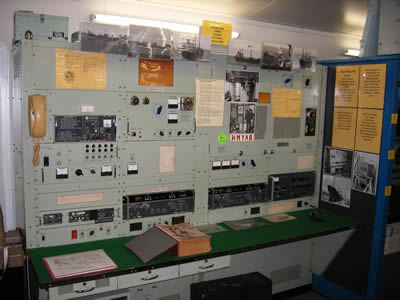
Korean ship Pong Su Radio Room reconstructed.
These were all sorted and sent into secure storage.
Any items which did not meet theses criteria were destined for the
tip.
Understandably, some of these latter items had
great sentimental value to some of us, but they would not be of
any interest to the general public. Some us were motivated to add
a few of these things to the clutter in our garages, rather than
see them destroyed. Such actions were not always met with ringing
endorsement by our partners (enough said, I think).
When we were planning our excursion to the Kurrajong
Radio Museum, Allan Hennessy and I conceived a plan to offer a couple
of these items to Ian O'Toole, to add to his collection, if that
idea appealed to him. The three items were:-
(1) The “Sched Board” from the Managers office, at Bringelly
Receiving Station.
(2) The Great Circle Map, which accompanied the Sched Board.
(3) The Solas Clock, from Sydney Radio, which has the “Silence
Periods' of three minutes, marked in red, every quarter hour.
The first of these items is a peg-board about 1.5
x 2 meters across, which has recorded on it every radio service
scheduled for reception, including every technical detail involved
in that operation. The second is nearly as big and it has a long
perspex wand, suspended on a pin in the middle (located at Bringelly)
which can be spun to identify the G.C. bearing required for that
reception. The clock was much smaller, but accommodating the three
items in the boot of Allan’s car proved rather tricky.
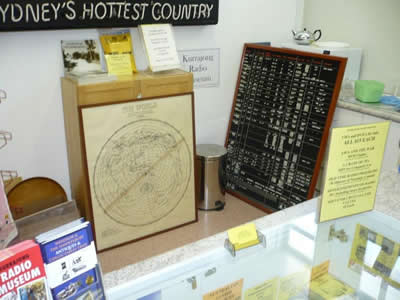
Great Circle Map from La Perouse donated by OTVA
to the Kurrajong Radio Museum.
Any apprehensions or doubts we may have had about
this were quickly dispelled when Ian saw what we had brought with
us. He was absolutely euphoric and is determined to find a prominent
wall space to hang them all. There is no doubt that these items,
which would mean next to nothing to most people, were genuinely
valued here and will be treasured. It made our visit all the more
satisfying.
After our visit, we had lunch at a nearby restaurant, overlooking
the scenic valley, before returning home.
“OTC Remains An Extravagant
Excrescence.” [Top]
Bob Emanuel recounts the first attempt
by a Labor Government to amalgamate OTC and Telecom Australia. This
account is compiled from the published writings of Edgar Harcourt
and Gough Whitlam.
The Vernon Royal Commission was set up by Gough
Whitlam’s government in 1973 to examine the structure of the
Postmaster General’s Department, which had both postal and
telecommunications functions, and also to enquire whether OTC should
remain a separate business from the domestic telecommunications
body, the soon to be set up Telecom Australia.
The Chairman was Sir James Vernon with B.J. Callinan
and J.J. Kennedy completing the Commission.
Hundreds of submissions were received and examined.
Trips were made to the US and the UK to examine the industry in
those countries.
Sir James had been a Chairman of CSR, and had also been a Royal
Commissioner under the McMahon Government.
The Royal Commission reported back to Parliament
on April 19th, 1974. The recommendations were that the Post Office
should be independent of the Public Service and that separate statutory
corporations should be established for the postal and telecommunications
services.
Those decisions were unanimous – but the
decision on the amalgamation of OTC and the new Telecom Australia
was a majority decision not supported by the Chairman, Sir James
Vernon. He was impressed by OTC’s business acumen and the
service given to its customers, whereas the other members were convinced
that an amalgamation was required.
J.J. Kennedy was appointed as chairman of an interim
board of the Postal Commission.
A.G Gibbs, chairman of the Victorian Railways and
formerly MD of General Motors Holden was appointed to the chairman
of the interim board for the Telecommunications Commission.
The two Commissions came into effect on the 31st
of July, 1974.
I can’t put it any better than Gough Whitlam,
in his memoir, “The Whitlam Government” who continues:-
“Even so, the cosy bureaucracy in OTC promoted
the formation of an Overseas Telecommunications Users’ Association.
A former chairman of OTC, Bert Chadwick, was persuaded to be president
of the association. He wrote to 100 companies which were thought
to be OTC’s largest customers. He chaired a meeting of about
48 of these customers in Melbourne. Peter Golding, as his proxy,
chaired a meeting of some 35 of them in Sydney. The Opposition obliged
with the necessary amendments in the Senate. OTC remains an extravagant
excrescence.”
Sources: E.G. Whitlam, The Whitlam Government,
Penguin Books, Australia, 1985, pp 697 to 699. Edgar Harcourt, Taming
The Tyrant: The first 100 years of Australia's international telecommunications
services pp 382 to 383.
For Robin
Tuckfield the proposed amalgamation was a catalyst to a great career.
I remember, and I was not happy!
I remember the General Manager at the time coming
out to "keep us informed" and it seemed like it was going
to be 50/50 whether we amalgamated or not.
I was a TO1 (Technical Officer Grade 1) new boy.
I hadn't come through the OTC training school, and had joined OTC
because of the exciting and interesting company it was. I had been
in the company 3 years. I did not want to be a Telecom Tech. I had
turned down Telecom twice before. A TO1 in Telecom was 1 in 10,000
with no prospects for advancement for 20 years. If we were going
to be amalgamated then I needed to be at least a TO2!
There was a restructure at the time of the political
discussions, and there were several TO2 jobs going. I was told I
should get a TO2 at Paddo, but that was too much of a gamble for
me. I applied for every TO2 job going in OTC, whether I had the
qualifications or not.
Because I was one of a very few applicants (maybe
1) for the TO2 (Restoration) at Network Arrangements, that was the
position I got.
Well did I get rubbished. Fancy giving up working
at Paddo to work in HO!
However I am pleased to say that it was one of
the great decisions I made. Maybe I missed out on a bit of shift
work penalties, but working with Denis Grant, Darryl Smith, Ross
Craig, George Kennedy and the only PTO in OTC at the time, Hedley
Caswell (He unfortunately passed away while I was there.) Ron Becket
came to join me later. I learned more about OTC and satellites than
I would have at Paddo. The experience of those two years helped
me all through my career.
What are your memories of this time? Please drop
your editor a line. Contact details at the front.
More on Doug Lloyd
Henry Cranfield had to bail Doug out on Guam.
Doug Lloyd was sent to Guam and tried to make
out how useless their security was on the various bases we had to
visit. One night at about 11.30PM I received a telephone call from
the base security officer art Andersen Air Force Base asking me
if I had a Douglas Lloyd on my staff. Wondering "What Next"
I said yes and he asked me to come immediately and get him as he
had been arrested at North West Field contravening base security!
N.W Field was the Guam equivalent of Nurrangar near Alice Springs
and very hush-hush. So I went and bailed him out and found out that
Doug had tried them out to the Nth Degree.
When you drove out to the facility (which was
at the North West end of Andersen AFB and an old abandoned WW-2
fighter field. It still had the revetments where they parked the
planes), you were challenged at the gate a few miles down the road
and instructions were you drove straight down to the compound where
you were challenged again for I.D. etc and you parked your vehicle
and walked to the main building where e you again had to show your
ID and sign in. They had to telephone the operations area who sent
an escort to the door so that you did not stray inside the building.
Well! Our Doug passed through the first gate OK
and then decided he would try out the security by diverting through
these revetments with the Ute lights switched off.
Suddenly, he was lit up like fairy land by 4 trucks
with searchlights and Air Police, armed with sub machine guns and
told to switch off the engine, get out of the cabin and put his
hands up. They then drove him to the base security and rang me.
The result was no more visits to N.W. Field as next day I had to
go up to Andersen and pour oil on troubled waters and was told he
was banned.
And people wonder why my hair turned grey?
Gwen Salloway – May 2008
Bernie White recently received the news that
Gwen Salloway, widow of Jack Salloway of SOR passed away in May
2008. No further details are yet known.
Paying Your Annual Subscriptions
via BPay. [Top]
You can now use BPay to pay your annual subscriptions
to OTVA.
Contact Bernie White for account details.
Please ensure that your transaction can be clearly identified by
entering your name and purpose of transfer in the "To account
transaction description" or similar window.
An example could be: "P.Bull OTVA Subs" or just "P.Bull
Subs" if your bank's EFT system limits the number of characters
that can be entered.
Where the source of any money transfers cannot be readily identified
it will be difficult and time consuming for our Treasurer to determine
the owner of the money and, as such, the money may have to be treated
as an anonymous donation to OTVA until such time as the issuer of
the money supplies a copy of their bank statement to the Treasurer
to support any ownership claims.
It wasn’t always noses
to the grindstone. Dave Stimson recalls some of the staff exploits
at home and on the out-stations that never made the official histories.
‘Bedlam at the ITMC Paddo’
A motor cycle with no muffler roars through the
darkened ITMC area at 2 am and disappears down the fire escape.
Staff are left bewildered. I can now expose the rider’s identity
as ex-OTC tech Paul Black. He once mixed up some ammonia and iodine
crystals paste (an explosive) and daubed various on/off switches
and door knobs throughout the building - always a joker.
‘Wrong Chain’
The day Jack Creswick ran down the main transmitter
hall at Doonside, jumped out through the loading dock doors planning
to grab the traveling crane block chain and swing back in. Sadly
it was the free running chain he caught and plunged to the ground.
As many people will attest, I don’t think he ever recovered.
Jack went on to further infamy with a home made
compressed air tank made from a beer keg – the pressure relief
valve failed (or wasn’t fitted) and blew a hole through the
garage wall and neighbor’s fence.
He also attempted to test his home made 2 phase
electric welder by borrowing a phase off Leo Mahoney who lived next
door at the time. The pole fuses in the street blew! Council staff
scratched their heads – pole fuses are rated at 1000 amps.
A Merry Christmas and a Happy New Year to all members
of OTVA and their families.
It has been an interesting challenge taking on
the newsletter editor’s role but I have thoroughly enjoyed
it. I rely on your feedback to let me know how I’ve gone –
don’t hesitate to tell me what you like, what you don’t
like, what you’d like more of and what you’d like less
of.
And - spotted in their local newspapers of late
are Trevor Thatcher on amateur radio and Barry Stockbridge wielding
the BBQ tongs.
|

 Fellow
Members of the OTVA, as Christmas draws near, I reflect upon another
year of development and progress in our association.
Fellow
Members of the OTVA, as Christmas draws near, I reflect upon another
year of development and progress in our association. 
 Let
me begin this story with a disclaimer. Most of this is hearsay and
it was told to me by someone who (sadly) cannot protest his innocence.
Like many of the best stories we all know about episodes in our
careers, this tale was never supposed to appear in print, due to
fears of libel suits or worse.
Let
me begin this story with a disclaimer. Most of this is hearsay and
it was told to me by someone who (sadly) cannot protest his innocence.
Like many of the best stories we all know about episodes in our
careers, this tale was never supposed to appear in print, due to
fears of libel suits or worse. 


